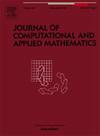Fourier-feature induced physics informed randomized neural network method to solve the biharmonic equation
IF 2.1
2区 数学
Q1 MATHEMATICS, APPLIED
Journal of Computational and Applied Mathematics
Pub Date : 2025-03-14
DOI:10.1016/j.cam.2025.116635
引用次数: 0
Abstract
To address the sensitivity of parameters and limited precision for randomized neural network method (RNN) with common activation functions, such as sigmoid, tangent, and Gaussian, in solving high-order partial differential equations (PDEs) relevant to scientific computation and engineering applications, this work develops a Fourier-feature induced physics informed single layer RNN (FPISRNN) method. This approach aims to approximate the solution for a class of fourth-order biharmonic equation with two boundary conditions on both unitized and non-unitized domains. By carefully calculating the differential and boundary operators of the biharmonic equation on discretized collections, the solution for this high-order equation is reformulated as a linear least squares minimization problem. We further evaluate the FPISRNN method with varying hidden nodes and scaling factors for uniform distribution initialization, and then determine the optimal range for these two hyperparameters. Numerical experiments and comparative analyses demonstrate that the proposed FPISRNN method is more stable, robust, precise, and efficient than other FPISRNN approaches in solving biharmonic equations for both regular and irregular domains.
傅立叶特征诱导的随机神经网络方法求解双调和方程
为了解决具有常见激活函数(如sigmoid、正切和高斯函数)的随机神经网络方法(RNN)在求解与科学计算和工程应用相关的高阶偏微分方程(PDEs)时参数的敏感性和有限精度,本工作开发了傅里叶特征诱导物理通知单层RNN (FPISRNN)方法。本文的目的是对一类具有两个边界条件的四阶双调和方程在统一域和非统一域上的近似解。通过仔细计算离散集合上双调和方程的微分算子和边界算子,将该高阶方程的解重新表述为线性最小二乘最小化问题。我们进一步评估了具有不同隐节点和缩放因子的均匀分布初始化FPISRNN方法,并确定了这两个超参数的最优范围。数值实验和对比分析表明,该方法在求解规则域和不规则域双谐方程方面都比其他方法具有更强的稳定性、鲁棒性、精度和效率。
本文章由计算机程序翻译,如有差异,请以英文原文为准。
求助全文
约1分钟内获得全文
求助全文
来源期刊
CiteScore
5.40
自引率
4.20%
发文量
437
审稿时长
3.0 months
期刊介绍:
The Journal of Computational and Applied Mathematics publishes original papers of high scientific value in all areas of computational and applied mathematics. The main interest of the Journal is in papers that describe and analyze new computational techniques for solving scientific or engineering problems. Also the improved analysis, including the effectiveness and applicability, of existing methods and algorithms is of importance. The computational efficiency (e.g. the convergence, stability, accuracy, ...) should be proved and illustrated by nontrivial numerical examples. Papers describing only variants of existing methods, without adding significant new computational properties are not of interest.
The audience consists of: applied mathematicians, numerical analysts, computational scientists and engineers.

 求助内容:
求助内容: 应助结果提醒方式:
应助结果提醒方式:


